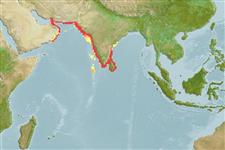Environment: milieu / climate zone / depth range / distribution range
Ecology
Marine; demersal; depth range 2 - 300 m (Ref. 28016), usually 10 - 120 m (Ref. 11441). Tropical; 29°N - 5°N, 56°E - 83°E (Ref. 5222)
Indian Ocean: continental shelf of the northern Indian Ocean from the Gulf of Aden to Sri Lanka and Madras, India. Not known from the Persian Gulf nor the Red Sea. Records from the western Pacific are based on misidentifications of Epinephelus stictus or Epinephelus fasciatomaculos.
Length at first maturity / Size / Weight / Age
Maturity: Lm 39.2 range ? - ? cm
Max length : 55.0 cm TL male/unsexed; (Ref. 3)
Occurs over muddy sand or mud substrata and caught in depths of 63 to 100 m off the Kerala coast. Minimum depth reported taken from Ref. 9773.
Heemstra, P.C. and J.E. Randall, 1993. FAO Species Catalogue. Vol. 16. Groupers of the world (family Serranidae, subfamily Epinephelinae). An annotated and illustrated catalogue of the grouper, rockcod, hind, coral grouper and lyretail species known to date. Rome: FAO. FAO Fish. Synop. 125(16):382 p. (Ref. 5222)
IUCN Red List Status (Ref. 130435: Version 2024-1)
Threat to humans
Harmless
Human uses
Fisheries: commercial
Tools
Special reports
Download XML
Internet sources
Estimates based on models
Preferred temperature (Ref.
123201): 22.5 - 28.6, mean 27 °C (based on 280 cells).
Phylogenetic diversity index (Ref.
82804): PD
50 = 0.5000 [Uniqueness, from 0.5 = low to 2.0 = high].
Bayesian length-weight: a=0.01096 (0.00941 - 0.01277), b=3.03 (3.00 - 3.06), in cm total length, based on LWR estimates for this species (Ref.
93245).
Trophic level (Ref.
69278): 4.0 ±0.52 se; based on food items.
Resilience (Ref.
120179): Medium, minimum population doubling time 1.4 - 4.4 years (K=0.21-0.86; Fec=4,165).
Fishing Vulnerability (Ref.
59153): Low to moderate vulnerability (27 of 100).
Nutrients (Ref.
124155): Calcium = 97.8 [43.3, 230.3] mg/100g; Iron = 1.08 [0.49, 2.64] mg/100g; Protein = 17.9 [16.3, 19.5] %; Omega3 = 0.243 [0.127, 0.461] g/100g; Selenium = 88.2 [41.0, 208.6] μg/100g; VitaminA = 29.5 [6.8, 121.5] μg/100g; Zinc = 1.14 [0.71, 1.89] mg/100g (wet weight);
